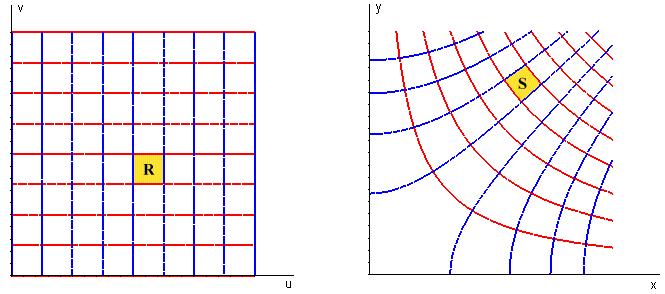|
|
|
|
|
|
 It is often useful
to convert from one set of parameters to another. This conversion is called
a change of coordinates and can be expressed as a pair of functions from
one set of parameters, or coordinates, to the other set.
It is often useful
to convert from one set of parameters to another. This conversion is called
a change of coordinates and can be expressed as a pair of functions from
one set of parameters, or coordinates, to the other set.
We have already seen some useful changes of variables, for example the change from Cartesian to polar coordinates in the plane. In particular, this transformation is often useful for simplifying certain integrals.
 ,
,
first using the given Cartesian variables, and then using polar coordinates in the plane. Plot the domain over which the integration is being carried out.
In the shift from Cartesian to
polar coordinates in double integrals, we see that dx dy becomes
r dr d![]() , but where
does the "r" come from? In deriving our integral formulas,
as we subdivided the domain with a polar grid, we had to "scale" each
little region by its distance from the origin, so this is our local change-in-area
factor for the Cartesian-to-polar transformation. It corresponds in some way
to the change of variables
, but where
does the "r" come from? In deriving our integral formulas,
as we subdivided the domain with a polar grid, we had to "scale" each
little region by its distance from the origin, so this is our local change-in-area
factor for the Cartesian-to-polar transformation. It corresponds in some way
to the change of variables
x(r,![]() )
= r cos
)
= r cos ![]() ,
,
y(r,![]() ) = r
sin
) = r
sin ![]() .
.
In the Cartesian-to-polar case, we could solve the scale problem by elementary geometry. Our task now is to relate this to the algebra of coordinate changes so we can find the local change-in-area factor, no matter what the transformation is.
We have a hint about what we are
looking for: the factor used
to compute the length of a curve for a parametric representation r(t) = (x(t),y(t))
of a curve C in the xy-plane. For that case, we identified |r'(t)|
as the local change-in-length factor that accounts for the stretching and compression
done by the function r. We then found the length of the curve for ![]() as
as
![]() .
.
For curves, we were able to identify the change-in-length factor because a curve is locally linear. For surfaces, we will obtain the local change-in-area factor using the fact that the surface is locally planar. We consider first the case where the transformation is literally in the plane (as in polar to Cartesian coordinates), and then we extend this to parameterization of a surface, for which two coordinates (parameters) are being transformed into space.
Here is a generic transformation of coordinates in the plane:

The left figure shows a coordinate grid in the (u,v) plane, with the curves u = constant in blue and the curves v = constant in red. Suppose the transformation formulas into the (x,y) plane are x = x(u,v) and y = y(u,v). Then a blue curve, say u = c, is transformed in the right figure to a blue curve parameterized by (x(c,v),y(c,v)). Similarly, a red curve, say v = k, is transformed in the right figure to a red curve parameterized by (x(u,k),y(u,k)). In the process, a typical coordinate rectangle R in the (u,v) plane is transformed into a "curvilinear rectangle" S in the (x,y) plane. The boundaries of S are formed by the parameterized curves.
Here is a closer look at R and S:

The local change-in-area factor is the ratio of the area of S to the area of R -- that is, the factor by which the area grows or shrinks under the transformation. We can calculate the area of S approximately as the area of the parallelogram determined by the two vectors shown on the right. These are tangent vectors to the parameterized curves, and we know how to calculate tangent vectors as "velocities" -- the "speed" (i.e., magnitude of the velocity vector) is the local change-of-length factor for a parameterized curve. Since each type of curve results from holding one of the variables constant, the relevant derivatives are the partial derivatives of x and y with respect to u and v. Specifically, the tangent vectors are given by
tu = xu(u,v) i + yu(u,v) j,
tv = xv(u,v) i + yv(u,v) j.
These vectors are scaled by the grid spacings du and dv, respectively, to get the vectors on the right that approximate the curve segments in the xy-plane. We calculate the approximate area of S as
|tu x tv| du dv,
where now we are thinking of the planar vectors as being in space, so the cross product is in the k direction. Since the area of R is du dv, the length of the cross product is the local change-in-area factor.
|
|
|
| modules at math.duke.edu | Copyright CCP and the author(s), 2002 |